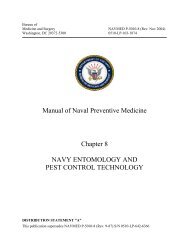ENVIRONMENTAL FINAL GOVERNING STANDARDS ITALY
ENVIRONMENTAL FINAL GOVERNING STANDARDS ITALY
ENVIRONMENTAL FINAL GOVERNING STANDARDS ITALY
Create successful ePaper yourself
Turn your PDF publications into a flip-book with our unique Google optimized e-Paper software.
<strong>ITALY</strong> - 3 Drinking Water<br />
system and during the month of warmest water temperature. Systems remain on the reduced schedule as<br />
long as the average of all samples taken in the year is no more than 0.030 mg/L for TTHM and 0.045 mg/L<br />
for HAA5. Systems that do not meet these levels must revert to routine (quarterly) monitoring the<br />
following quarter.<br />
6. A system is noncompliant if the annual average of all samples taken that year exceeds the TTHM MCL,<br />
0.030 mg/L or the HAA5 MCL, 0.060 mg/L.<br />
7. Sample must be taken at the point of maximum residence time in the distribution system and during the<br />
month of warmest water temperature. If annual sample exceeds MCL (TTHM or HAA5) the system must<br />
increase monitoring to one sample per treatment plant per quarter at the point of maximum residence time.<br />
The system may return to routine monitoring if the annual average of quarterly samples is no more than<br />
0.030 mg/L for TTHM and 0.045 mg/L for HAA5.<br />
8. No reduced monitoring schedule is available. Noncompliance exists when the annual sample (or average of<br />
annual samples is conducted) exceeds the TTHM MCL, 0.030 mg/L or if the HHA5 concentration exceeds<br />
the MCL, 0.060 mg/L.<br />
9. For TTHM and HAA5, a DoD system using only ground water NOT under the influence of surface water<br />
that treats its water with a chemical disinfectant must collect the number of samples listed above. Samples<br />
must be taken at a location in the distribution system reflecting the maximum residence time of water in the<br />
system.<br />
10. System may reduce monitoring to one sample per treatment plant per year if the system meets all of the<br />
following conditions: a) the annual average for TTHM is no more than 0.030 mg/L; b) the annual average<br />
for HAA5 is no more than 0.030 mg/L; and c) at least one year of routine monitoring has been completed.<br />
Sample must be taken at the point of maximum residence time in the distribution system and during the<br />
month of warmest water temperature. Systems remain on the reduced schedule as long as the average of all<br />
samples taken in the year is no more than 0.030 mg/L for TTHM and 0.045 mg/L for HAA5. Systems that<br />
do not meet these levels must revert to routine monitoring the following quarter.<br />
11. Noncompliance exists when the annual average of quarterly averages of all samples, compounded<br />
quarterly, exceeds the TTHM MCL, 0.030 mg/L or the HHA5 the MCL, 0.060 mg/L.<br />
12. For TTHM and HAA5, a DoD system using only ground water NOT under the influence of surface water<br />
that treats its water with a chemical disinfectant must collect the number of samples listed above. One<br />
sample per treatment plant must be taken at a location in the distribution system reflecting the maximum<br />
residence time of water in the system and during the month of warmest water temperature. If the sample<br />
exceeds the MCL, the system must increase monitoring to quarterly.<br />
13. System may reduce monitoring to one sample per three-year monitoring cycle if the system meets all the<br />
following conditions: a) the annual average for TTHM is no more than 0.030 mg/L; b) the annual average<br />
for HAA5 is no more than 0.030 mg/L; and c) at least one year of routine monitoring has been completed.<br />
Sample must be taken at the point of maximum residence time in the distribution system and during the<br />
month of warmest water temperature. Systems remain on the reduced schedule as long as the average of all<br />
samples taken in the year is no more than 0.030 mg/L for TTHM, and 0.045 mg/L for HAA5. Systems that<br />
do not meet these levels must revert to routine monitoring. Systems on increased monitoring may return to<br />
routine monitoring if the annual average of quarterly samples does not exceed 0.030 mg/L for TTHM and<br />
0.045 mg/L for HAA5.<br />
14. Noncompliance exists when the annual sample (or average of annual samples) exceeds the TTHM MCL,<br />
0.030 mg/L or the HHA5 the MCL, 0.060 mg/L.<br />
15. For systems using chlorine dioxide for disinfection or oxidation, daily samples are taken for chlorite at the<br />
entrance to the distribution system for chlorite. The monthly chlorite samples are collected within the<br />
distribution system, as follows: one as close as possible to the first customer, one in a location<br />
representative of average residence time, and one as close as possible to the end of the distribution system<br />
(reflects maximum residence time within the distribution system).<br />
16. Additional monitoring is required when a daily sample exceeds the chlorite MCL, 0.70 mg/L. A threesample<br />
set (following the monthly sample set protocol) is required to be collected the following day.<br />
Further distribution system monitoring will not be required in that month unless the chlorite concentration<br />
at the entrance to the distribution system again exceeds the MCL, 0.70 mg/L.<br />
17. For chlorite, systems may reduce routine distribution system monitoring from monthly to quarterly if the<br />
chlorite concentration in all samples taken in the distribution system is below the MCL, 0.70 mg/L, for a<br />
period of one year and the system has not been required to conduct any additional monitoring. Daily<br />
samples must still be collected. Monthly sample set monitoring resumes when if any one daily sample<br />
exceeds the MCL, 0.70 mg/L.<br />
September 2012 Italy FGS 3-32<br />
Revision 0
















